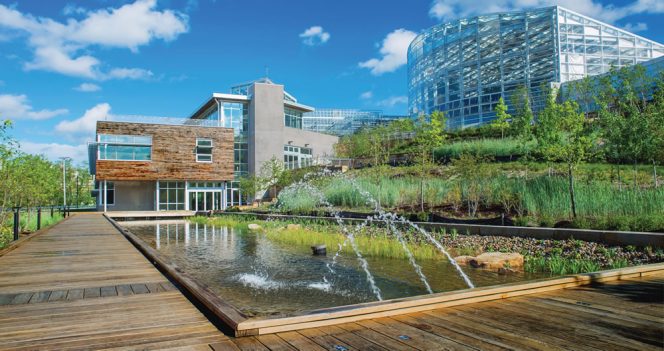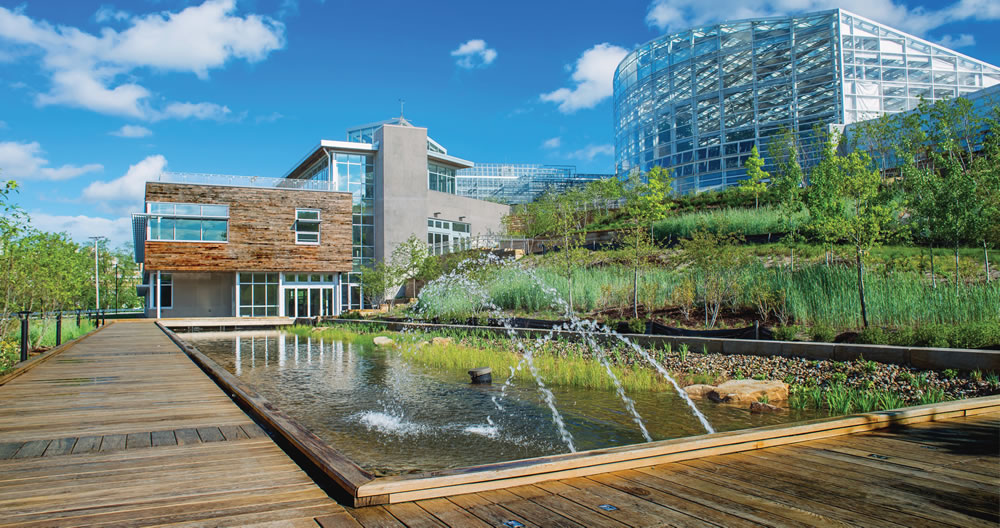SITES® offers a rating system that defines what a sustainable site is and, ultimately, elevates the value of landscapes in the built environment.
Sarah Buente
BioCycle May 2016

The Center for Sustainable Landscapes at Phipps Conservatory and Botanical Gardens achieved the highest level of SITES® certification under the pilot program.
SITES offers a rating system designed to define what a sustainable site is and, ultimately, elevates the value of landscapes in the built environment. The rating system can be applied to development projects located on sites with or without buildings — ranging from national parks to corporate campuses, from streetscapes to gardens and much more.
In 2015, Green Business Certification Inc. (GBCI) officially acquired SITES from the University of Texas and ASLA. The Wildflower Center and ASLA continue to support GBCI in the creation and implementation of the SITES credentialing and certification offerings by training project reviewers and providing educational opportunities for pursuing SITES certification.
GBCI’s administration of the SITES rating system enables the program to be taken to the next level and will ensure its future growth and influence toward market transformation. GBCI, the third-party organization that exclusively oversees credentialing and certification of the U.S. Green Building Council’s (USGBC) LEED, or Leadership in Energy and Environmental Design, green building rating program has also expanded to administer several other complementary rating systems and programs including PEER, the WELL Building Standard, the GRESB Benchmark, EDGE and ParkSmart (see sidebar).
GBCI launched project certification for the second version (v2) of SITES in June 2015. The SITES v2 Rating System draws on the experience gained from a two-year pilot program involving more than 150 projects. Already, SITES v2 has seen projects registering across the world from New York to Los Angeles, to Vancouver to Hong Kong and much more. Just as LEED transformed the built environment, SITES has the ability to transform land development and use under the administration of GBCI.
Creating Healthy Functioning Ecosystems
Traditional land development and land use decisions often underestimate or ignore healthy ecosystems. Sustainable land development is cost-effective, better for the land and fosters resiliency. The four overarching goals of SITES v2 are: Create regenerative systems and foster resiliency; Ensure future resource supply and mitigate climate change; Transform the market through design, development and maintenance practices; and Enhance human wellbeing and strengthen the community.
The framework of SITES is based on the concept of ecosystem services, the benefits provided by the natural ecological processes working all around us that support our daily lives. Land is a crucial component of the built environment and can be planned, designed, developed and maintained to protect and enhance the benefits derived from healthy, functioning landscapes. SITES benefits the environment, property owners and local and regional communities and economies.
Sustainable landscapes provide ecosystem services and create ecologically resilient communities that are better able to withstand and recover from floods, droughts, wildfires and other catastrophic events. Additionally, SITES-certified projects help reduce water demand by requiring less maintenance and filtering and reducing storm water runoff. These projects involve no — or limited — pesticide use, conserve or restore natural resources, enable wildlife habitat and offset development impacts. They also reduce energy consumption, help sequester carbon, improve air quality and promote human health and wellbeing by connecting people to nature, to their communities and to each other.
The Center for Sustainable Landscapes (CSL) at Phipps Conservatory and Botanical Gardens in Pittsburgh, Pennsylvania, is one example of a project using best practices in landscape, design, construction and management to directly address environmental challenges. One of the first projects in the world to simultaneously achieve LEED Platinum certification, the highest level of SITES certification (under the pilot program) and the Living Building Challenge certification, the Phipps Center uses an integrative approach to landscape management that restores ecosystem services, generates energy and cleans and reuses on-site wastewater.
Built on a former brownfield, the nearly three-acre site is designed to be net-zero energy and water. On-site solar photovoltaics meet 99 percent of the CSL’s annual energy demand, a single wind turbine meets an additional 1 percent and 14 geothermal wells significantly offset the building’s HVAC energy requirements. In addition, the CSL was designed to use 50 percent less energy than a comparable conventional office building. To achieve net-zero water, all greywater and blackwater is treated on-site using passive systems and ultraviolet filters and then reused as toilet flushing water or converted to distilled water for orchid irrigation.
Additional sustainable landscape management features in place at the CSL include managing all sanitary waste and a 10-year storm event on-site using green infrastructure strategies that provide source control and green filters for storm water runoff. Underground storage enables the project to harvest an estimated 500,000 gallons of storm water runoff annually from the roofs of neighboring buildings and reuse it as irrigation water in the conservatories. A 4,000 square foot storm water lagoon at the CSL stocked with native wildlife also captures this runoff.

Navy Pier in Chicago focused on soils in the retrofit of its South Dock and Gateway Plaza areas. Left: Tree pits inserted into the South Dock, which previously was a continuous concrete slab. Right: Tree pits completed and hardscaping and seating installed.
Sites V2 Rating System: Spotlight On Chicago Navy Pier
SITES v2 includes 18 prerequisites and 48 credits for measuring site sustainability. These strategies cover both predesign and design and construction activities and are tied together through an integrative process. Throughout the rating system, particular attention is placed on soils because of their significant contribution to healthy functioning ecosystems and the services they provide.
SITES v2 requires a robust assessment of the existing soil conditions on-site and the identification of important and healthy soils. If no healthy soils are found on-site, an appropriate reference soil native to the region needs to be identified. Once the assessment is complete, a comprehensive soil management plan needs to be completed prior to construction. This vital plan sets the baseline for healthy soil protection and proper restoration of disturbed areas. SITES v2 requires that all soils disturbed during construction — that will exist in a vegetated state at the end of the project — be restored back to the physical and chemical or biological characteristics of the undisturbed reference soil. The rating system also allows additional credit for restoring soils that may have been previously disturbed prior to the development activities. (See sidebar for prerequisites and credits in SITES v2 Rating System that address soils.)
Chicago’s Navy Pier, which is currently undertaking a comprehensive plan to retrofit the pier’s South Dock and Gateway Plaza area, has embraced this focus on soils. A major public landmark, Navy Pier’s retrofit aims to transform the site into a more seasonally dynamic, culturally rich and sustainable destination. The project is committed to achieving SITES v2 certification; Phase 1 of the project is expected to be complete in May 2016. The comprehensive assessment of existing conditions led to the formation of a detailed soil management plan.
This plan specifies how Navy Pier’s construction activities are designed to minimize soil disturbance, how disturbed soils will be remediated and how restored soils will be specifically tested to confirm they meet the project’s performance criteria. The plan covers all soil zones within the project and includes tree, plant and soil protection areas, as well as detailed instructions for soil preparation and soil mixes in each restoration zone (including pre and post-construction soil testing). To restore soils, amendments are being used at the project, including: drainage gravel, processed sand, organic amendment, compost, loamy sand soil, fiber reinforcement, coral calcium and a biological soil fertility amendment package.
The plan also highlights appropriate equipment staging areas and describes important maintenance activities associated with the project. Navy Pier’s soil management plan serves as a detailed roadmap for the contractors and maintenance personnel, ensuring that soil continues to be prioritized through construction and operation of the project.
Sarah Buente is Marketing & Communications Project Manager with the U.S. Green Building Council.










